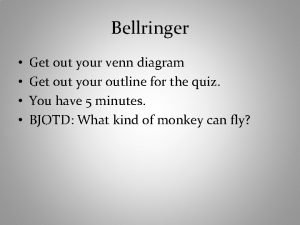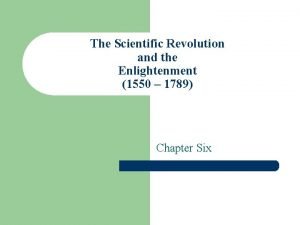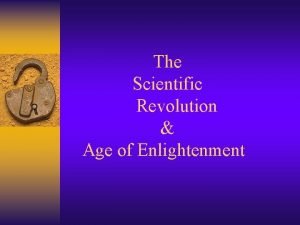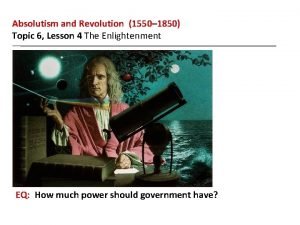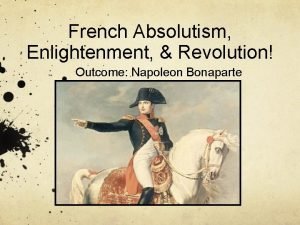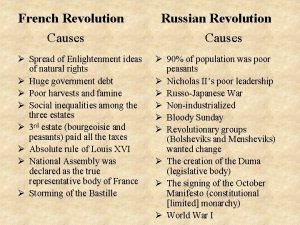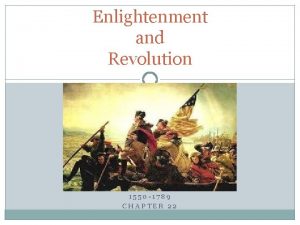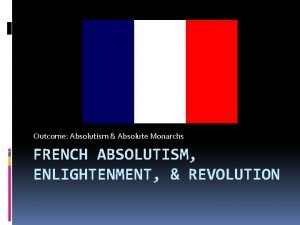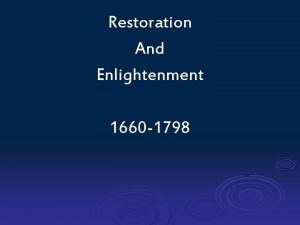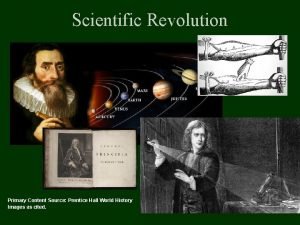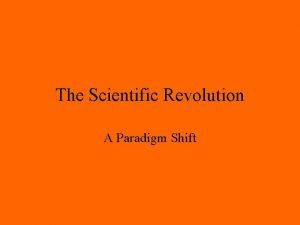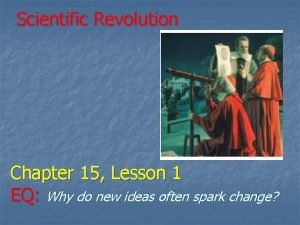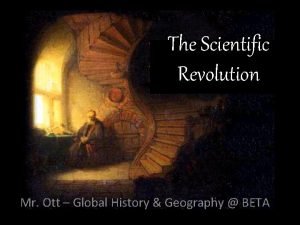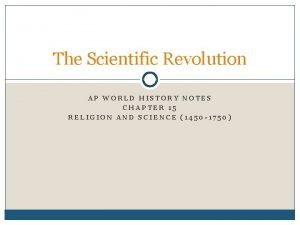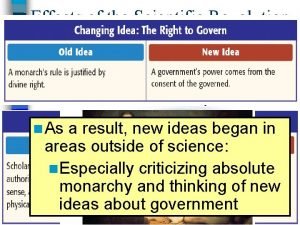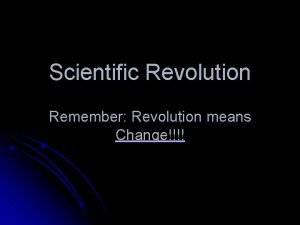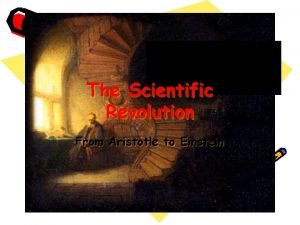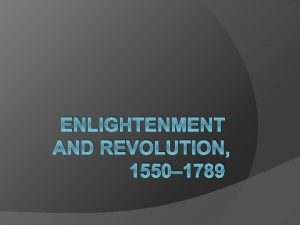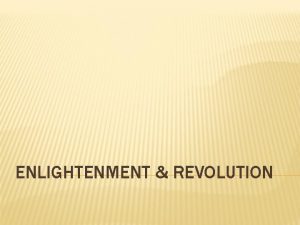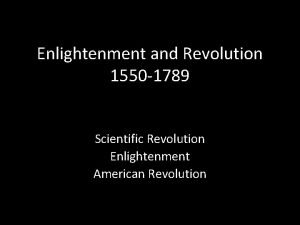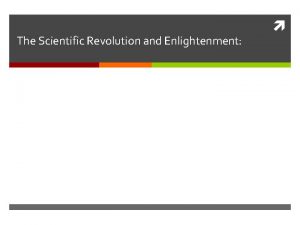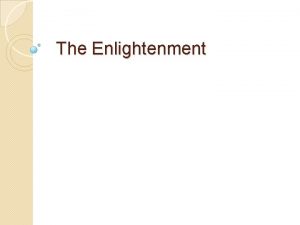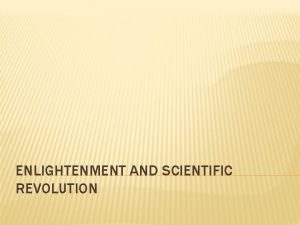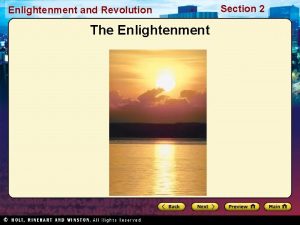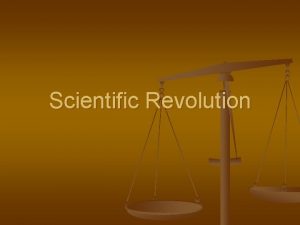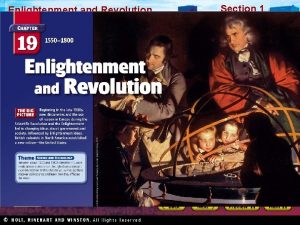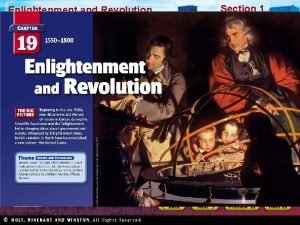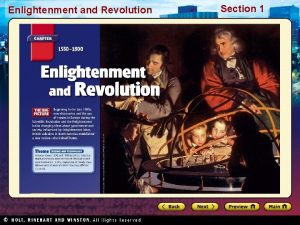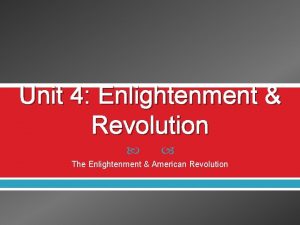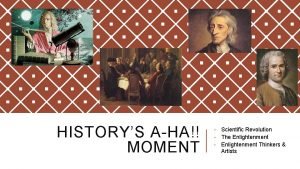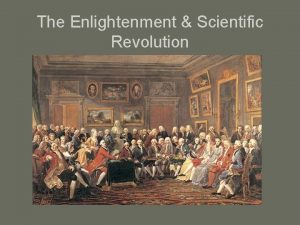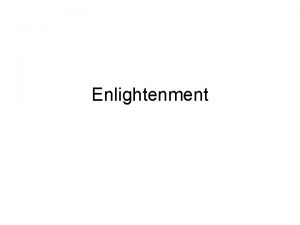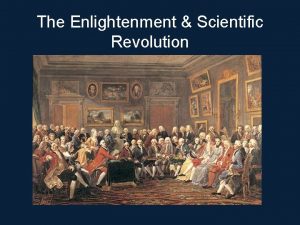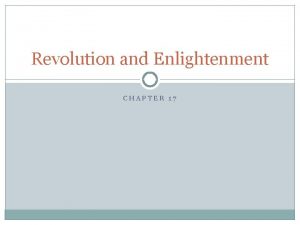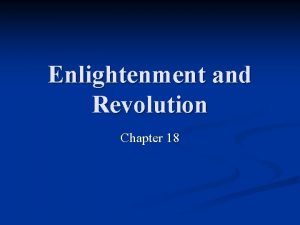The Enlightenment Scientific Revolution The Enlightenment period of






















































- Slides: 54

The Enlightenment & Scientific Revolution

The Enlightenment= period of new ideas thoughts on government, the individual, and society Before Church Monarch Dependent Individual After Autonomous Rational Individual

Roots of the Enlightenment ►The Enlightenment grew out of the Renaissance, Reformation, and the Scientific Revolution. ►What’s the same? : Like all of these other movements, much Enlightenment thinking challenged accepted beliefs. ►What’s new? : Enlightenment philosophers wanted to use the ideas and reason of the Scientific Revolution for problems in government and society.

The Salons ► In France, thinkers called philosophes (French for “philosophers”) championed the idea of reason in government. ► Philosopher: a scholar or thinker ► Philosophers often gathered in informal meetings, called salons. There they exchanged and debated ideas for hours. ► Many salons were organized by women. ► Gatherings like these helped to shape and spread the ideas of the Enlightenment.

What a concept! ►Enlightenment thinkers rejected authority and upheld the freedom of individuals to think for themselves. ►Rene Descartes: “I think, therefore I am. ”

Enlightenment and Government ► Enlightenment thinkers criticized accepted ideas about government. Some questioned the medieval belief in the divine right of kings ► Many Enlightenment thinkers stressed individual rights that governments must respect. ► Enlightenment thinkers also felt that people should have a say in their government.

Enlightenment and Religion ►Enlightenment thinkers believed humans were capable of discovering truth for themselves. ►Many believed in an all powerful deity (or God), but not in a specific church or holy book. Some called themselves Deists [Dee-ists]. ►Right and Wrong should be based on rational insight.

Thomas Hobbes • English writer of Leviathan • Social Contract = citizens give up some freedom they would have in a state of nature (like the freedom to rob and kill people), and in exchange the government protects citizens’ right to life, liberty, and property. • People are born evil • Without laws, people would always be in conflict. • It is a strong ruler’s duty to keep the people in line and they should obey

Without government our lives would be nasty, brutish, and short!” Hobbes

John Locke • English writer of Two Treatises on Government • Blank Slate Theory- human beings are born with a blank mind and they acquire knowledge through their environment/experiences • People are born free & equal • Natural Rights=human beings are born with fundamental, basic rights. (life, liberty, property, and the freedom to find happiness).

John Locke • Consent of the Governed= when governments had a responsibility to hold up their end of the social contract. If a government failed, then citizens would no longer agree to be governed and they would have the right to revolt. • Locke was in favor of constitutional monarchies

All people have the natural rights, including life, liberty, and property. ” Locke

Baron de Montesquieu – French writer of On the Spirit of Laws – Believed in the separation of power= By dividing different powers among more than one branch of government, no one group in the government could grow too powerful. – Should have checks and balances to make sure no one branch would be able to control too much power

“To become truly great, one has to stand with people, not above them. " Montesquieu

Jacques Rousseau • French writer of The Social Contract • The social contract was among the people of society • General Will should direct the government as to what direction to go • Noble Savage- people are born free but society corrupts them

“No man has any natural authority over his fellow men. ” Rousseau

Voltaire • French writer on freedom of expression: – Freedom of speech – Religious toleration – Separation of church & state ► His most famous novel was Candide, in which he poked fun at old religious ideas.

“I disagree with what you say, but I will defend to the death your right to say it” Voltaire

Mary Wollstonecraft • English advocate for women’s rights/education • Wrote A Vindication of the Rights of Woman

“Strengthen the female mind by enlarging it, and there will be an end to blind obedience. ” Wollstonecraft

Why is this important? ► Many of our own ideas about government, such as the Declaration of Independence and the American Constitution got their ideas directly from the Enlightenment. ► In fact, many of America’s founding fathers studied the ideas of the Enlightenment thinkers during the American Revolution. Left to right: Benjamin Franklin, John Adams, Thomas Jefferson

Impact of the Enlightenment on Government • Modern views of government owe a great deal to Enlightenment thinkers. The Enlightenment influenced monarchs in Europe, especially "enlightened despots, " and greatly affected revolutions in America and France.

Enlightened Rule by Monarchs • Despot: a king or other ruler with absolute, unlimited power. • The Enlightenment did not change Europe overnight. Many countries still had kings. Some of them became “enlightened despots” by using enlightenment ideas in their countries. • Examples: Some kings ended the use of torture, started universities, and used religious tolerance. They wanted to keep the people happy without losing their power.

The “Enlightened Despots” • Catherine II of Russia – She recommended religious toleration, abolishment of torture, and capital punishment. • Frederick the Great of Prussia – His reforms included religious freedoms, reduced censorship, improved education, improved justice system and abolishing torture. Frederick's changes only went so far, for example he believed that serfdom was wrong but he did nothing to end it since he needed the support of wealthy landowners. • Maria Theresa and Joseph II of Austria – She separated the executive from judicial functions and reorganized the offices of defense, commerce, the interior, foreign affairs, and justice. She tried to restrict government expense and regulate taxes. Her domestic reforms included a new penal code and humanitarian laws to help the poor. She also began a compulsory primary education system. Joseph abolished serfdom

The American and French Revolutions • Both America and France had revolutions overthrowing their kings. However, the revolution in France was much more violent.

The Scientific Revolution

What is a Revolution? • A Revolution is a complete change, or an overthrow of a government, a social system, etc.

The Scientific Revolution • In the 1500 s and 1600 s the Scientific Revolution changed the way Europeans looked at the world. • People began to make conclusions based on experimentation and observation, instead of merely accepting traditional ideas.

Before the Scientific Revolution… Ptolemy (87 -140 A. D. ) • Until the mid 1500’s, European scholars accepted and believed the teachings of Ptolemy, an ancient Greek astronomer. • Ptolemy taught that the Earth was the center of the universe. • People felt this was common sense, and the geocentric theory was supported by the Church. • It was not until some startling discoveries caused Europeans to change the way they viewed the physical world.

Before the Scientific Revolution… Ptolemy (87 -100 A. D. ) Ptolemy’s geocentric model of the solar system: 1. 2. 3. 4. 5. 6. 7. 8. Earth Moon Mercury Venus Sun Mars Jupiter Saturn • Notice, the Earth is first, and not the sun, as it should be.

Nicolaus Copernicus • Copernicus was a Polish astronomer who studied in Italy. • In 1543 Copernicus published On the Revolutions of the Heavenly Spheres. • In his book, Copernicus made two conclusions: 1. The universe is heliocentric, or sun-centered. 2. The Earth is merely one of several planets revolving around the sun.

Nicolaus Copernicus’ model of the solar system: 1. 2. 3. 4. 5. 6. 7. 8. Sun Moon Mercury Venus Earth Mars Jupiter Saturn • Notice, the sun is first, not the Earth, as Ptolemy believed.

Nicolaus Copernicus • Copernicus came to these conclusions using mathematical formulas. • The Copernican conception of the universe marked the start of modern science and astronomy.

The Copernican Heliocentric Model

Reaction to Copernicus • Most scholars rejected his theory because it went against Ptolemy, the Church, and because it called for the Earth to rotate on its axis. • Many scientists of the time also felt that if Ptolemy’s reasoning about the planets was wrong, then the whole system of human knowledge could be wrong.

Tycho Brahe • Then, in the late 1500 s, the Danish astronomer Tycho Brahe provided evidence that supported Copernicus’ heliocentric theory. • Brahe set up an astronomical observatory. • Every night for years he carefully observed the sky, accumulating data about the movement of the stars and planets.

Johannes Kepler • After Brahe’s death, his assistant, the German astronomer and mathematician Johannes Kepler, used Brahe’s data to calculate the orbits of the planets revolving around the sun. • Kepler’s calculations supported Copernicus’ heliocentric theory. • His calculations also showed that the planets moved in oval shaped orbits, and not perfect circles, as Ptolemy and Copernicus believed. • Kepler’s finding help explain the paths followed by man-made satellites today.


Galileo Galilei • Galileo Galilei was an Italian astronomer who built upon the scientific foundations laid by Copernicus and Kepler. • Galileo assembled the first telescope which allowed him to see mountains on the moon and fiery spots on the sun. • He also observed four moons rotating around Jupiter – exactly the way Copernicus said the Earth rotated around the sun. • Galileo also discovered that objects fall at the same speed regardless of weight.

Galileo Galilei • Galileo’s discoveries caused an uproar. Other scholars came against him because like Copernicus, Galileo was contradicting Ptolemy. • The Church came against Galileo because it claimed that the Earth was fixed and unmoving. • When threatened with death before the Inquisition in 1633, Galileo recanted his beliefs, even though he knew the Earth moved. • Galileo was put under house arrest, and was not allowed to publish his ideas.



The Scientific Method • By the early 1600 s, a new approach to science had emerged, known as the Scientific Method – painstaking method used to confirm findings and to prove or disprove a hypothesis. • Scientists observed nature, made hypotheses, or educated guesses, and then tested these hypotheses through experiments. • Unlike earlier approaches, the scientific method did not rely on the classical thinkers or the Church, but depended upon a step-by-step process of observation and experimentation.

The Scientific Method 1. 2. 3. 4. 5. 6. 7. State the problem Collect information Form a hypothesis Test the hypothesis Record & analyze data State a conclusion Repeat steps 1 – 6 • Scientists soon discovered that the movements of bodies in nature closely followed what could be predicted by mathematics. • The scientific method set Europe on the road to rapid technological progress.

The Scientific Method Newton • Sir Isaac Newton was an English scholar who built upon the work of Copernicus and Galileo. • Newton was the most influential scientist of the Scientific Revolution. • He used math to prove the existence of gravity - a force that kept planets in their orbits around the sun, and also caused objects to fall towards the earth.

The Scientific Method Newton • Newton published his scientific ideas in his book Mathematical Principles of Natural Philosophy. • He discovered laws of light and color, and formulated the laws of motion: 1. A body at rest stays at rest 2. Acceleration is caused by force 3. For every action there is an equal opposite reaction • He invented calculus: a method of mathematical analysis.

The Scientific Method According to a popular story, Newton saw an apple fall from a tree, and wondered if the force that pulled the apple to the Earth also controlled the movement of the planets. Newton argued that nature followed laws.

The Scientific Method • Francis Bacon was an English philosopher who wrote Advancement of Learning. • Bacon popularized the scientific method and used it with philosophy and knowledge. • Bacon argued that truth could not be known at the beginning of a question, but only at the end after a long process of investigation. Francis Bacon

The Scientific Method René Descartes • Descartes was a French scientist, mathematician, and philosopher. • Descartes emphasized human reasoning as the best road to understanding. • Like Bacon, Descartes also believed that truth was only found after a long process of studying and investigation. “I think, therefore I am”

Other Scientific Advances… Chemistry Robert Boyle • In the 1600 s Robert Boyle distinguished between individual elements and chemical compounds. • Boyle also explained the effect of temperature and pressure on gases.

Other Scientific Advances… Medicine Andreas Vesalius • In 1543 Andreas Vesalius published On the Structure of the Human Body. • Vesalius’ book was the first accurate and detailed book on human anatomy.

Medieval human anatomy drawing before Vesalius

Drawings done by Vesalius

Other Scientific Advances… Medicine William Harvey • An English scholar who described the circulation of blood for the first time. • He showed how the heart served as a pump to force blood through veins and arteries.
 Scientific revolution and enlightenment speed dating
Scientific revolution and enlightenment speed dating Newton's first law of motion
Newton's first law of motion Enlightenment vs scientific revolution
Enlightenment vs scientific revolution Scientific revolution and enlightenment speed dating
Scientific revolution and enlightenment speed dating Absolutism and revolution lesson 4 the enlightenment
Absolutism and revolution lesson 4 the enlightenment French absolutism enlightenment & revolution
French absolutism enlightenment & revolution French absolutism enlightenment & revolution
French absolutism enlightenment & revolution 3 ideas of the enlightenment
3 ideas of the enlightenment French absolutism enlightenment & revolution
French absolutism enlightenment & revolution Chapter 22 building vocabulary enlightenment and revolution
Chapter 22 building vocabulary enlightenment and revolution French absolutism enlightenment & revolution
French absolutism enlightenment & revolution Restoration and enlightenment
Restoration and enlightenment Third agricultural revolution definition
Third agricultural revolution definition Russian revolution vs french revolution
Russian revolution vs french revolution Did american revolution cause french revolution
Did american revolution cause french revolution Causes of scientific revolution
Causes of scientific revolution Scientific revolution primary sources
Scientific revolution primary sources Effects of scientific revolution
Effects of scientific revolution The scientific revolution chapter 6 section 1
The scientific revolution chapter 6 section 1 How do new ideas spark change
How do new ideas spark change Lesson 1 the scientific revolution answer key
Lesson 1 the scientific revolution answer key Effects of scientific revolution
Effects of scientific revolution Scientific revolution ap world history
Scientific revolution ap world history What were the effects of the scientific revolution?
What were the effects of the scientific revolution? Whats the scientific revolution
Whats the scientific revolution Newton's first law of motion
Newton's first law of motion Jupiter's moons
Jupiter's moons How did the reformation help spur the scientific revolution
How did the reformation help spur the scientific revolution What did isaac newton do in the scientific revolution
What did isaac newton do in the scientific revolution Period of revolution formula
Period of revolution formula Scientific inquiry vs scientific method
Scientific inquiry vs scientific method How is a scientific law different from a scientific theory?
How is a scientific law different from a scientific theory? Nonmetal period 3 mass 32
Nonmetal period 3 mass 32 Critical period vs sensitive period
Critical period vs sensitive period Prehistory vs history
Prehistory vs history Critical period vs sensitive period
Critical period vs sensitive period In this period, youth became completely rebellious.
In this period, youth became completely rebellious. A&p flix activity: propagation of an action potential
A&p flix activity: propagation of an action potential Approaches to child development
Approaches to child development Stability period vs measurement period
Stability period vs measurement period Is hyperpolarization the same as refractory period
Is hyperpolarization the same as refractory period This period lasted from approximately 1775 - 1825
This period lasted from approximately 1775 - 1825 Trustee period and royal period
Trustee period and royal period Critical period vs sensitive period
Critical period vs sensitive period đặc điểm cơ thể của người tối cổ
đặc điểm cơ thể của người tối cổ Cách giải mật thư tọa độ
Cách giải mật thư tọa độ Thang điểm glasgow
Thang điểm glasgow ưu thế lai là gì
ưu thế lai là gì Thẻ vin
Thẻ vin Cái miệng nó xinh thế chỉ nói điều hay thôi
Cái miệng nó xinh thế chỉ nói điều hay thôi Các châu lục và đại dương trên thế giới
Các châu lục và đại dương trên thế giới Từ ngữ thể hiện lòng nhân hậu
Từ ngữ thể hiện lòng nhân hậu Bổ thể
Bổ thể Tư thế ngồi viết
Tư thế ngồi viết Diễn thế sinh thái là
Diễn thế sinh thái là
